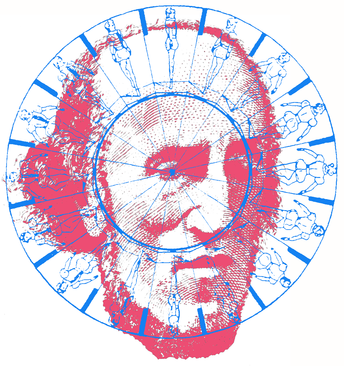Joseph Antoine Ferdinand Plateau1801–1883
Plateau was a pioneer in the study of visual persistence. In 1832 he invented a means of presenting stimuli briefly and in sequence (the phenakistoscope) to yield apparent motion. At about the same time similar devices were invented independently by Simon Stampfer (1792-1864) in Vienna with the stroboscopic disc and by William Horner (1786-1837) in Bristol with the daedeleum (later called the zoetrope), and these philosophical toys are the forerunners of motion pictures. Roget claimed to have made one earlier. The phenakistoscope consisted of a disc with slits at regular intervals around its circumference paired with a sequence of slightly different designs, like a dancing figure; when the disc is rotated the designs are exposed in sequence through the slits and the figure appears to move. Plateau is shown in his diagram of a pirouetting dancer. He also conducted experiments on the motion aftereffect using a spiral pattern: “When one rotates the disc in the direction of the arrow for sufficiently long, but not until the eyes are tired, and then turns to another object, e.g., the face of a person, one sees a remarkable phenomenon: namely, it appears as if the head of the person shrinks. If the disc is rotated in the opposite direction the effect is reversed: the head appears to expand.” These were the first systematic experiments on the motion aftereffect, and the Plateau spiral became the principal stimulus used to study motion aftereffects in the latter half of the nineteenth century. Plateau carried out his studies of visual persistence and motion aftereffects before his ill-advised experiment on afterimages: he was temporarily blinded after looking at the sun for 20 s in order to generate a long lasting afterimage, and he became permanently blind in 1842 from uveitis. Despite this handicap he continued to work on a range of subjective visual phenomena until shortly before his death. Towards the end of his life he published a series of annotated bibliographies of works on subjective vision from antiquity until the end of the 18th century. Plateau was born in Brussels and became professor of physics and astronomy at the University of Ghent in 1834. His father was an artist, and he conducted a number of significant studies using colours. When colours are presented briefly and in succession their apparent intensity is proportional to the time of presentation. This photometric relationship is now known as the Talbot-Plateau law, as it had earlier been formulated in a less precise way by William Henry Fox Talbot (1800-1877), the pioneer of the negative process in photography. On the basis of experiments with painters mixing greys to appear midway between specified white and black papers, Plateau proposed a power function as an alternative to Fechner’s logarithmic law. He also showed that accidental colours (afterimages) mixed with coloured stimuli and with one another according to the laws of colour mixture.
